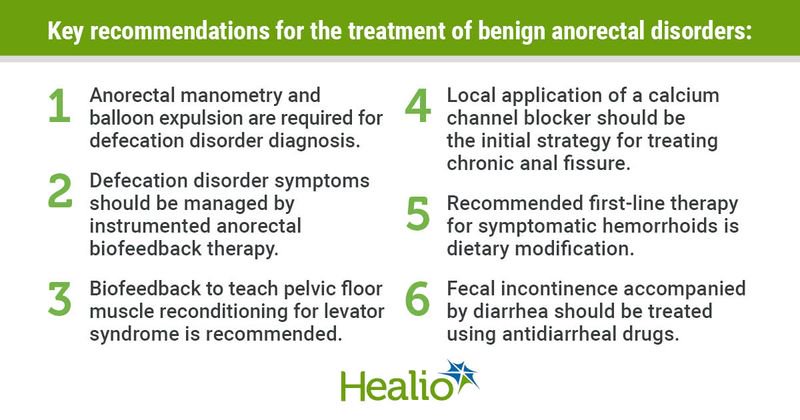ACG issues practice guidelines for management of benign anorectal disorders
Click Here to Manage Email Alerts
The ACG published clinical practice guidelines on the preferred approach and management strategy for defecation disorders, proctalgia syndromes, hemorrhoids, anal fissures and fecal incontinence.
“Disorders of defecation, proctalgia syndromes and fecal incontinence are primarily regarded as disorders of function; some patients also have structural abnormalities. The structural disorders include acute and chronic anal fissures and hemorrhoids,” Arnold Wald, MD, MACG, of the division of gastroenterology and hepatology at the University of Wisconsin School of Medicine and Public Health, and colleagues wrote. “The guidelines consist of individual sections that cover the definitions, epidemiology and/or pathophysiology, diagnostic testing and treatment recommendations.”

Scientific evidence for these guidelines were derived from systematic reviews and meta-analyses; assessment was done using the Grading of Recommendations Assessment, Development and Evaluation (GRADE) process. Expert consensus developed key concept statements when the evidence was lacking. These guidelines are considered as the preferred approach, but researchers noted they are not the only approaches to management of these conditions.
Key strategy recommendations for the treatment of benign anorectal disorders follow.
Researchers strongly recommend the utilization of digital rectal examination as part of the evaluation to identify structural abnormalities and assess anal sphincter function in defecation disorders, though anorectal manometry and balloon expulsion are required for diagnosis.
Defecation disorder symptoms should be managed by instrumented anorectal biofeedback therapy.
Defined by a history of recurring anorectal pain episodes lasting at least 20 minutes and the absence of other causes of pain by history and diagnostic testing, chronic proctalgia diagnosis is strengthened by observed tenderness on palpation of the levator ani muscles.
Biofeedback to teach pelvic floor muscle reconditioning for levator syndrome is recommended, but electrical galvanic stimulation may be used when biofeedback is not available.
Local application of a calcium channel blocker should be the initial strategy for treating chronic anal fissure. In the event of calcium channel blocker avoidance or failure, botulinum toxin A injection may be used.
Recommended first-line therapy for symptomatic hemorrhoids is dietary modification, though patients with acutely thrombosed external hemorrhoids may benefit from surgical excision or incision and evacuation of the thrombus.
When fecal incontinence is accompanied by diarrhea, antidiarrheal drugs are recommended; nonresponse to education and conservative measures should lead to biofeedback measures.
“These guidelines are established to support clinical practice and suggest preferable approaches to a typical patient with a particular medical problem based on the currently available published literature,” Wald and colleagues wrote. “When exercising clinical judgment, particularly when treatments pose significant risks, health care providers should incorporate this guideline in addition to patient-specific medical comorbidities, health status and preferences to arrive at a patient-centered care approach.”
